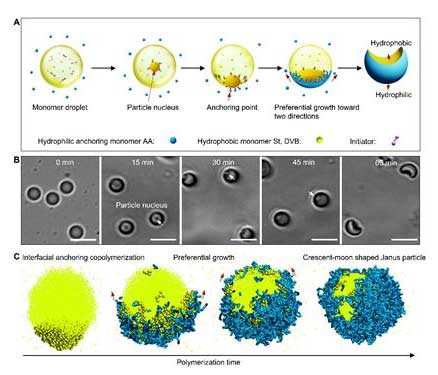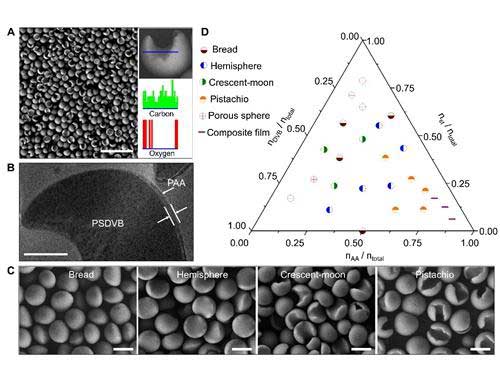| Posted: Jun 29, 2017 |
New avenue for the large-scale synthesis of Janus particles
(Nanowerk News) Chinese researchers have developed an emulsion interfacial polymerization method to fabricate Janus particles exhibiting chemical and topological anisotropy.
|
|
Results were published in the journal Science Advances ("A general strategy to synthesize chemically and topologically anisotropic Janus particles").
|
 |
| This figure shows the emulsion interfacial polymerization mechanism for producing Janus particles. (Image: Dr. FAN Junbing)
|
|
Polymer particle materials have a giant effect on daily human life, largely due to the topology and surface chemistry of polymer particles. Emulsion polymerization is a traditionally leading synthesis technique for particles. However, it usually produces spherical particles due to surface tension, posing a challenge for fine-tuning the topology and chemistry of particles.
|
|
To overcome the limitation of surface tension, researchers from the Technical Institute of Physics and Chemistry of the Chinese Academy of Sciences recently developed a general emulsion interfacial polymerization approach to synthesizing a large variety of Janus particles with controllable topological and chemical anisotropy.
|
|
In the study, they chose to use a typical oil-in-water emulsion system - styrene (St) and divinyl benzene (DVB) in water emulsion - into which hydrophilic monomers (e.g., acrylic acid (AA) or acrylamide (AM), etc.) were introduced as anchoring molecules. The polymerization was initially designed to occur inside an oil droplet.
|
|
The researchers found that a particle nucleus could be produced inside oil droplets and the particle nucleus would move toward the oil/water interface. The hydrophilic anchoring monomers in the external water phase could then contact the particle nucleus and be initiated to polymerize, triggering interfacial anchoring polymerization.
|
|
On the interface, based on the principle of equal chemical potential at equilibrium, preferential copolymerization of AA, St and DVB occurred along the interface in two directions, resulting in the formation of crescent-moon shaped Janus particles.
|
 |
| This is the synthesis and characterization of the Janus particles. (Image: Dr. FAN Junbing)
|
|
The researchers' theoretical simulation consistently suggested preferential growth, similar to what they obtained in the experiment.
|
|
This novel method will significantly expand the utility of Janus particles, creating new opportunities in a wide variety of applications, ranging from the environment to health, especially in those involving oil-water separation and biological detection.
|
|
The approach can produce Janus particles with anisotropic topologies and amphiphilicity (Fig.2). The researchers' emulsion polymerization approach produced approximately 5 g of uniform Janus particles in one batch, providing an effective way to synthesize Janus particles on a large scale.
|
|
Their emulsion interfacial polymerization strategy can be used for polymerizing various vinyl monomers, including positively charged, neutrally charged and negatively charged ones, greatly enriching the community of Janus particles. This method can also be expanded to large-area fabricate two-dimensional Janus film actuators (NPG Asia Materials, "A monolithic hydro/organo macro copolymer actuator synthesized via interfacial copolymerization" and: Materials Chemistry Frontiers, "Recent progress in interfacial polymerization").
|


